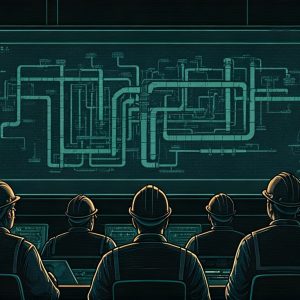In a session snatched between Symposium ’88 briefings and a trip to Basingstoke, Fred Fassman, IBM’s division director, systems planning at the White Plains-based System Products Division found time to give energetic answers to a number of 9370-related issues. Sophie Hanscombe put the questions.
With the AS/400 a clear success and the 9370 a disappointment, when will we see the so-called Fort Knox merged 38-370 machine?
Fassman dismissed Fort Knox – the migrating machine dreamed up to combine 370 and System 38 architecture – as an illogical business proposition, arguing that totally different requirements now separate 9370 and AS/400 users. While organisations without internal programming staff might pick the AS/400 to run specific software solutions and business applications, the 9370 would be chosen primarily for its connectivity, graphics, computational and distributed support capabilities, he explained. Thanks to the 9370’s remote down loading and fault-diagnosis potential, continued Fassman, a company should be able to centralise its – expensive programming personnel around the mainframe, and scatter unattended 9370s in appropriate sites – an arrangement that he believes will come into its own in Europe when trade barriers come down in 1992. In the US, claimed Fassman, IBM has now met its 9370 network target of one system programmer for every 25 to 30 systems. Fassman did concede, however, that armed with today’s application tools, software development is easier on the AS/400: consequently, he added, IBM is currently developing richer tools, based on an Alcatel product, to span the different range of sub-systems enveloped by the 9370 architecture. At a broader level, concluded Fassman, both the market and IBM are being increasingly driven by application-specific considerations, with hardware now selected primarily on the basis of its software-optimising capabilities.
When do we see MVS on the 9370?
Shifting to MVS, and the question of whether, when the putative easy-to-use version is introduced, it will span the 9370 range, Fassman claimed that MVS can run on the 9375 60, and the 9377 80 and 90 today. In addition, he referred to a package which has just been released in the US, which has MVS running native on the 9370 with a Series 1 packaged in the rack. Meanwhile, he continued, IBM will maintain its current efforts to make MVS easier to install and operate, with the established long-term aim of implementing full Enterprise System Architecture on the 9370. And will this extend right down the line? That depends, answered Fassman somewhat predictably, on what the line is at the time.
What is the future of DOS/VSE?
Turning to clarify IBM’s position on the future of DOS-VSE, Fassman alluded to a five year development committment extending through to 1993. The recently announced Version 4.0, he continued, means that brand new code will be coming in 1989, with two piece delivery set for June and December. Long-term plans include attacking the other end of the MVS problem, by taking the MVS user interface closer to that of DOS-VSE, and making it easier to move from one system to the other over time. And will DOS-VSE still be here in 10 years time? I haven’t seen many systems go away he concluded.
Are we going to see a 4391?
Under corporate threats of death or worse, Fassman refused to be drawn on the possibility of a 4391 successor to the 4381, willing to admit only that growth for the 9370, the 4381 and the 3090 series users would be accommodated. Whether we need one design point, two design points or three was, he added, a matter of constant technical – and financial – debate, suggesting that IBM has yet to decide whether 9370 processor architecture can be stretched to meet a heavily degraded 3090 processor, or if a 4391 processor needs to be put in the middle.
Why not microcode VM into the processors and run everything it?
Discussion then turned to VM, and the suggestion that IBM should extend its 9370 philosophy of running everything under VM right across the 370 architecture.
Use of VM, argued Fassman, had shifted from its traditional operating system testing and applications development functions, with the Conversational Monitor System or CMS portion now being used for applications running natively. Similarly, vital new business growth was being generated by the addition to CMS of facilities such as TSAF, SNA LU6.2 and VTAM. Overall strategy appears to be keeping VM growing and open: we don’t want to over-microcode, he concluded, in order to leave the rest open for software enhancement.
Will Office kill Profs, DisOSS?
In what must surely be seen as an attempt to soothe worried Profs and DisOSS users, Fassman then turned to the vexed question of Systems Application Architecture’s common Office proposals. The recently announced AS/400 Office would be combined with both Profs and DisOSS, he said, in attempts to move all office systems to a common front end – but existing users can sleep easy: you don’t just drop two million Profs users overnight.
Will we see DB2 on the PS/2?
Final questions fell firmly into the when-will-we-see category, initially addressing the DB2 relational database on either the 9370 or the PS/2. Long-term, Fasmann implied, DB2 on the host mainframe will be accessible from any IBM system: there are absolutely no plans, however, for running the thing on the PS/2, and none indicated for the 9370.
And how about the desk-top 9370?
IBM has described a whole string of microprocessor implementations of the basic 370 CPU, and it is clear that the issue of a desk-top 9370 is not constrained by technology, but simple cost-effectiveness. With the Personal Computer, the PS/2 and the RT now cast as IBM’s single-user family, could a mini 9370 be sold at a reasonable price? Fassman – from the depths of the lift – thinks not.






